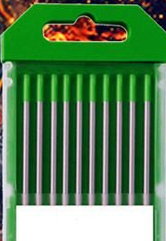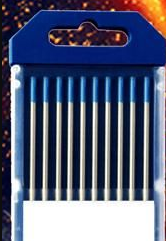Tungsten electrodes are widely used in various welding applications, especially in Tungsten Inert Gas (TIG) welding. The selection of the appropriate tungsten electrode and its color type plays a crucial role in achieving quality welds. Here are some guidelines to consider when choosing a tungsten electrode and understanding its color types:
Tungsten Electrode Types:
Pure Tungsten (Green Tip): Pure tungsten electrodes are composed of 99.5% tungsten and have a green color code. They are suitable for AC welding applications, primarily for aluminum and magnesium alloys. However, pure tungsten electrodes have poor resistance to contamination and may not provide as stable an arc as alloyed electrodes.
Thoriated Tungsten (Red Tip): Thoriated tungsten electrodes contain a small percentage of thorium oxide (usually 2% thorium). They have a red color code and are the most commonly used electrodes in DC welding applications. Thoriated electrodes offer good arc stability, excellent current-carrying capacity, and long electrode life. However, they emit low levels of radioactive particles during grinding, which poses potential health risks.

Pure Tungsten Electrode
Ceriated Tungsten (Gray Tip): Ceriated tungsten electrodes, marked with a gray color code, contain around 2% cerium oxide. They are versatile electrodes suitable for both AC and DC welding applications. Created electrodes provide excellent arc stability, good performance at low current levels, and resistance to weld contamination. They are often preferred as a safer alternative to thoriated electrodes.
Lanthanated Tungsten (Gold Tip): Lanthanated tungsten electrodes have a gold color code and are composed of 1-2% lanthanum oxide. They offer good arc stability, easy arc starting, and excellent resistance to contamination. Lanthanated electrodes are suitable for both AC and DC welding, including applications involving stainless steel, carbon steel, and non-ferrous metals.
Zirconiated Tungsten (Brown Tip): Zirconiated tungsten electrodes, marked with a brown color code, contain a small amount of zirconium oxide. They provide good resistance to contamination and high-temperature applications. Zirconiated electrodes are primarily used for AC welding, especially in applications involving aluminum and magnesium alloys.

Lanthanated Tungsten Electrode
Consider the Welding Application:
Determine the type of material you will be welding (e.g., aluminum, stainless steel, carbon steel) and the welding process (AC or DC). Different materials and processes may require specific tungsten electrode types for optimal performance and weld quality.
Current and Amperage Requirements:
Consider the current and amperage requirements of your welding application. Some tungsten electrodes are better suited for low amperage applications, while others can handle higher amperage levels. Consult the manufacturer's recommendations or welding guidelines for the appropriate electrode type based on your specific welding parameters.
Welding Conditions and Environment:
Take into account the welding conditions and environment in which you will be working. For example, if you are welding in a high-temperature environment or dealing with contaminants, electrodes with better resistance to contamination and higher-temperature capabilities may be more suitable.
Safety Considerations:
Be aware of the potential hazards associated with certain types of tungsten electrodes. Thoriated electrodes emit low levels of radioactive particles during grinding, so proper safety measures, such as wearing appropriate protective gear and using local exhaust ventilation, should be followed. Consider safer alternatives like created or lanthanide electrodes if you have concerns about radiation exposure.
For more information, please contact us. We will provide professional answers.







